
Contact Warmzone today.

Contact Warmzone today.
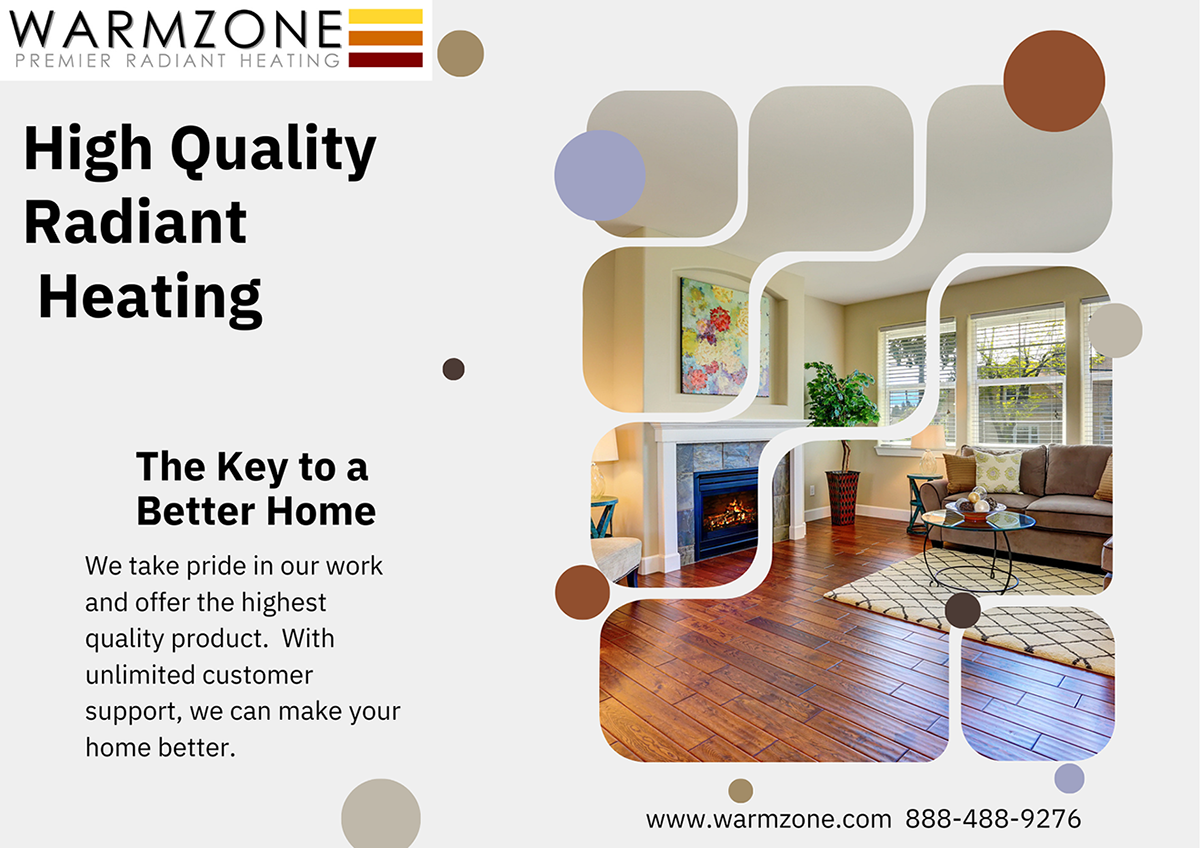
Contact Warmzone today.
The first day of spring has come and gone, yet most homeowners have still been left in the cold. Since winter seems intent on overstaying its welcome this year, thinking about preparing your home for the upcoming winter doesn’t seem so far-fetched.
Radiant heat is an ideal solution to protect often overlooked areas of the home or business. Freezing temperatures and heavy snow and ice can cause safety concerns as well as damage to roof and gutters. Ice and heavy snow buildup can create ice dams along roof edges. Runoff from snow trickles down the roof and refreezes along the eaves, creating ice dams. These dams prevent roof drainage and cause dangerous seepage that can threaten the integrity of the roof. Over time, water seepage into the home may cause mold and mildew, creating a serious health hazard.
Ice is also hazardous to pipes on the outside or interior of the home. Frozen pipes can burst and cause expensive water damage that can take months to repair. Heat trace cable is a simple, effective way to prevent the hassle of dealing with cold-weather damage to your home or business. Warmzone heat trace products are the optimal choice for protecting pipes or roofs from the hazards of harsh winter weather.
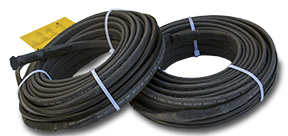
Warmzone’s roof de-icing systems feature efficient self-regulating heat trace cable. This heat cable consists of an irradiated conductive core housed in a rugged outer jacket that protects it from the elements. The specially designed core increases heat output as the temperature falls and decreases as the temperature rises. Each Warmzone system features an activation device so that the system can be activated manually or be fully automated. The advanced features and reliability of these systems make them extremely popular among customers.
Self-regulating cable is used in gutters, downspouts, valleys, or installed in a serpentine layout along roof eaves. Using self-regulating heat cable is an affordable option for protecting roofs by creating channels for the water runoff so that ice dams don’t develop. Installing self-regulating heat cable in gutters also helps to ensure that heavy snow and ice doesn’t accumulate and prevent runoff or cause damage to the gutters. Uniquely shaped roofs, trouble spots, or north-facing roof edges are also areas where cable installation can be particularly beneficial. Warmzone carries several variants of heat cable so that customers are assured of finding the ideal solution for their specific roof de-icing needs.
Heat trace cable from Warmzone is not only efficient but versatile. Running heat trace cables along the length of pipes to prevent freezing is another application that can alleviate worries, especially in a commercial setting. For pipe tracing, pre-terminated self-regulating cable and constant wattage heat cable are excellent choices. Warmzone’s self-regulating heat trace cable can also be used with other top-of-the-line roof de-icing systems. Combining systems allows you to create a completely custom de-icing solution that meets your specific needs. One popular, and often recommended option is to combine self-regulating heat trace cable with the low-voltage RoofHeat STEP system.
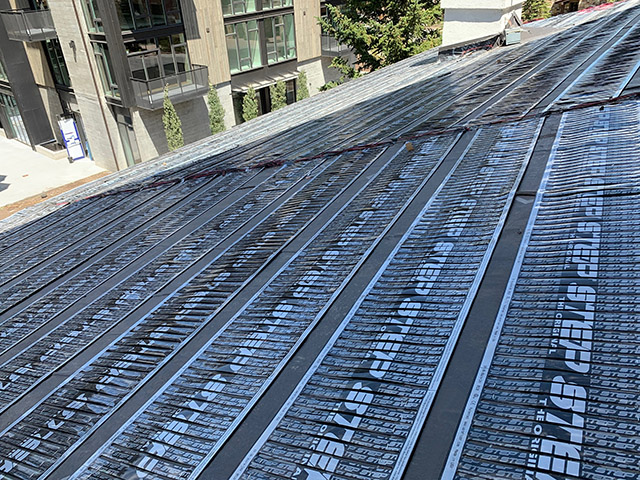
The innovative low-voltage STEP system features a thin, semi-conductive, flexible polymer heating element. The unique construction of the thin panel allows it to be nailed or stapled through, and can be discreetly installed under roof shingles. The versatile low-voltage heating element is available in rolls of 3, 6, 9, or 12-inch wide panels for installation in gutters, valleys and roof edges. The system utilizes transformers to control specific areas of the de-icing system, stepping down high voltage to low voltage (60 V or less). RoofHeat STEP systems also use an activation device that senses precipitation and temperature, making it fully automated and virtually maintenance-free.
Heat trace products from Warmzone will stand the test of time and keep your home comfortable, and protected from winter weather. If you’re not sure what products best suit your de-icing needs, call and talk with a friendly customer service professional. Our experts are happy to talk with you to help determine the best options for your home.
Warmzone custom designs each system to best meet the specific needs of each customer. These detailed system layouts also include all the electrical information for your electrician. Warmzone also includes free installation training and technical support. The free training can be completed with your instructor online via video conference (usually in less than an hour). If needed, installers can also call and speak with an expert at any phase of the installation. No matter what questions you have, a trained customer service professional is available to assist you.
Top-notch customer service sets Warmzone apart and ensures every customer receives the support needed to have their installation go off without a hitch. If you need help locating a qualified installer, Warmzone may also be able to help. Warmzone maintains relationships with experienced installers and electricians throughout the country, so we may be able to recommend a trusted installer in your area. Whatever your de-icing needs are, a friendly Warmzone professional can help you get started today. Reach out to Warmzone at 888-488-9276 and see what radiant heat can do for you this spring.
December is finally here. That means temperatures are dropping and snow will soon be falling. As beautiful as snow can be, it can also pose problems for homeowners. Perhaps the most prominent and troublesome challenges are those you can’t see – up on the roof.
The greatest potential for problems comes as a result of ice dams. An ice dam forms when snow melts at higher points on the roof, runs down, and refreezes when it reaches the colder eaves. Warm air that has escaped into the attic warms the bottom layer of snow on the roof, which runs down to the eaves. This water refreezes because there is no warm air under the eaves, causing a ridge of ice to form.
As the ridge of ice grows, water reaches the “dam” and pools behind it. When it refreezes and expands, tiny imperfections in the roof can be exploited. This is why ice dams have the potential to cause problems both to the roof and inside the home. Water may eventually seep inside the house, leading to interior water damage. If undiscovered, this can even be the cause of mold and mildew developing in the home. This is worst case scenario, but homeowners should be aware of potential problems so they can take steps to reduce or eliminate the need for costly repairs.
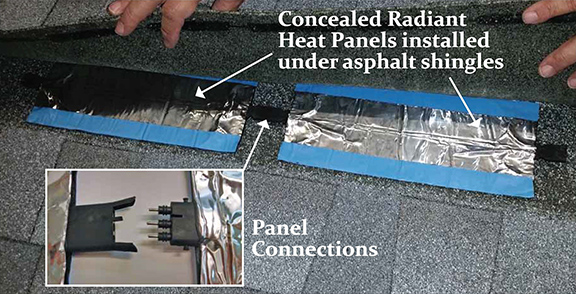
One preventive measure includes checking your attic insulation. Do what you can to prevent heat from escaping from the home into your attic. Also, inspect your roof every spring and fall. Keep the gutters and downspouts free of obstructions, such as small branches and leaves. If you notice snow and ice buildup in the same place every year, it may be time to consider installing a roof de-icing system.
Warmzone offers a variety of proven roof de-icing systems. The latest technology to be added to Warmzone’s reputable line of roof heating solutions is the RetroRoof de-icing system.
RetroRoof is one of the most advanced roof de-icing systems available today. It affords homeowners the option of discreetly adding a roof de-icing system to an existing roof. The thin heating panels feature adhesive strips on the top and bottom of the element, so it can be safely secured under the existing shingles. The system can also be installed in new construction applications, making RetroRoof an excellent solution for ice dam prevention on both new and existing roofs.
RetroRoof systems are designed to make it easy to add heat to existing roofs. The system’s modular design allows the installer to plug the heating panels together to keep entire areas free from snow and ice buildup. To install the heating panel, no nailing is required. Simply lift the shingle slightly, remove the underside release liner and secure the heating element underneath. Then remove the top side release liner and press down to seal the element to the next course of shingles. The innovative de-icing panel is now permanently and discreetly attached to the roof.
RetroRoof’s ease of installation and efficient performance makes them an excellent choice for any roof de-icing project. And remember, the RetroRoof system can be installed in new construction as well as retrofit applications. The heating elements effectively warm areas to keep them free of snow and ice. Installing the system under shingles along the roof edges is an ideal way to prevent ice dams and other ice/runoff problems from forming. RetroRoof offers a quick solution to any roof snow or ice problems.
RetroRoof panels are ETL Intertek listed and come with a 15-year limited warranty. The panels are easy to work with, and weigh less than 7 ounces per foot. RetroRoof de-icing systems are available in 120V and 240V, as well as various standard lengths. Certified to stand up to 110 MPH winds, and completely waterproof, RetroRoof panels are designed to weather Mother Nature’s worst storms. The flexibility and performance make RetroRoof panels an outstanding choice for heating almost any area of the roof.

RetroRoof systems are also compatible with Warmzone’s other industry-leading roof de-icing systems. Warmzone offers self-regulating heat trace cable that can be installed along roof edges or in gutters and downspouts to prevent freezing and gutter damage. These cables are easy to install, flexible, and affordable. The low-voltage RoofHeat STEP system is another outstanding option for homeowners. This premier system features a thin, self-regulating polymer heating element available in multiple widths. RoofHeat STEP is ideal for heating roof edges, and also a popular choice for heating roof valleys. It can be cut onsite and stapled or nailed through.
Warmzone’s RoofHeat aluminum panels feature attractive aluminum panels with pre-engineered channels for self-regulating heat cable. While not as discreet as RetroRoof, these panels are available in multiple finishes to boost the curb appeal of any home. The aluminum design also allows for maximum heat transfer across the entire panel. Warmzone de-icing systems also include an automated controller to safely and efficiently clear snow and ice before problems arise.
Combining any of these systems with Warmzone’s advanced RetroRoof de-icing panels allows home and business owners to create a comprehensive de-icing system specifically for their needs. A Warmzone professional will help you create a roof de-icing system that considers every aspect of your project and your budget. From professional design to installation training and support, customer service is all-inclusive at Warmzone. If you have more questions about Warmzone roof de-icing systems, call a Warmzone professional today at 888-428-9726.
Roofs are an integral part of any home or business, but maintenance during the hazardous winter months can be difficult. Cold weather, snow, and ice can lead to many dangerous liability issues for homes and businesses. Dripping water can cause icicles and black ice on walkways, leading to injuries and liability issues. And ice dams along roof eaves can eventually lead to roof damage.
An ice dam is a ridge of ice that forms when snow and ice melt and then refreeze on a roof. Heat from the attic can warm the roof and melt the bottom layer of snow. The runoff trickles toward the roof’s edge where it hits the cold eaves that cause it to refreeze. As it freezes, it forms a small ridge of ice. As addition water reaches this ridge, it also freezes, resulting in an ice dam that prevents water from draining properly. Once the dam is formed the melted snow is trapped, and pools behind the dam. The water can seep underneath your shingles and freeze again, threatening the integrity of your roof. Over time, roof damage can result, which may lead to additional problems inside the home. Seepage can find its way into the house where it may bring about costly problems, such as mildew or mold.
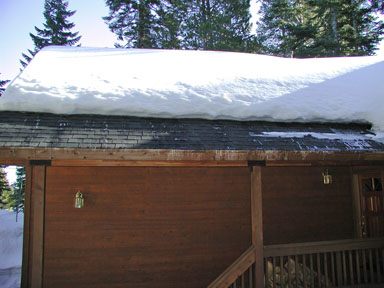
The most efficient solution for ice and snow problems on any property is a roof de-icing system. Warmzone offers two of the industry’s most efficient and trusted de-icing solutions: the RoofHeat STEP low-voltage roof de-icing system and the RoofHeat self-regulating heat trace cable. Both systems are operating in residential and commercial structures throughout the country.
When looking for roof de-icing options, determining the best products depends on the size, type, and construction of the roof, as well as regional weather conditions and performance requirements of the system. Taking these factors into consideration will help to ensure that correct components are used and installed correctly.
Warmzone’s self-regulating heat trace cable is an industry-leading product that is an affordable option for any home or business. Its superior construction makes it safe, effective, and energy efficient—the three key qualities of any roof de-icing system. Warmzone’s self-regulating heat trace cable is UL recognized under appliance classification file E 76498 and meets NEC codes section 426a, and also comes with 10-year warranty against manufacturer defects. The self-regulating cable features a durable UV stabilized outer casing built to withstand harsh winter weather conditions. The heat cable has an irradiated conductive core that regulates the heat output, increasing output as the outside temperature falls, and decreasing output as the temperature rises. Roof de-icing systems with self-regulating heat trace cable offer homeowners an affordable solution for heating roof edges, gutters, downspouts, and more. Installing a heat trace cable system is the ideal choice for those with a tighter budget.
Each self-regulating heat trace cable system consists of cable, a thermostat, and an activation device so that owners can operate the systems manually or set them to be fully automated. Running the heat cable along gutters and downspouts provides an excellent means for facilitating runoff, while keeping gutters free from the damaging effects of heavy snow and ice buildup. Using heat trace cable to heat specific trouble spots and roof valleys is also a cost-effective choice that will facilitate proper drainage. Warmzone’s roof heating cable is also consistently recommended for heating roof edges to prevent damage from ice dams and frost erosion. Heat cable is easily installed on roof edges. It is attached with special roof clips in a zigzag pattern along the entire edge of the roof eave. To create drip channels, the cable is installed to overhang an extra 5-inches on roofs with gutters, and 2-inches for roofs without gutters. Heat trace cable is also a great choice for pipe tracing in commercial or industrial applications to prevent pipes from freezing.
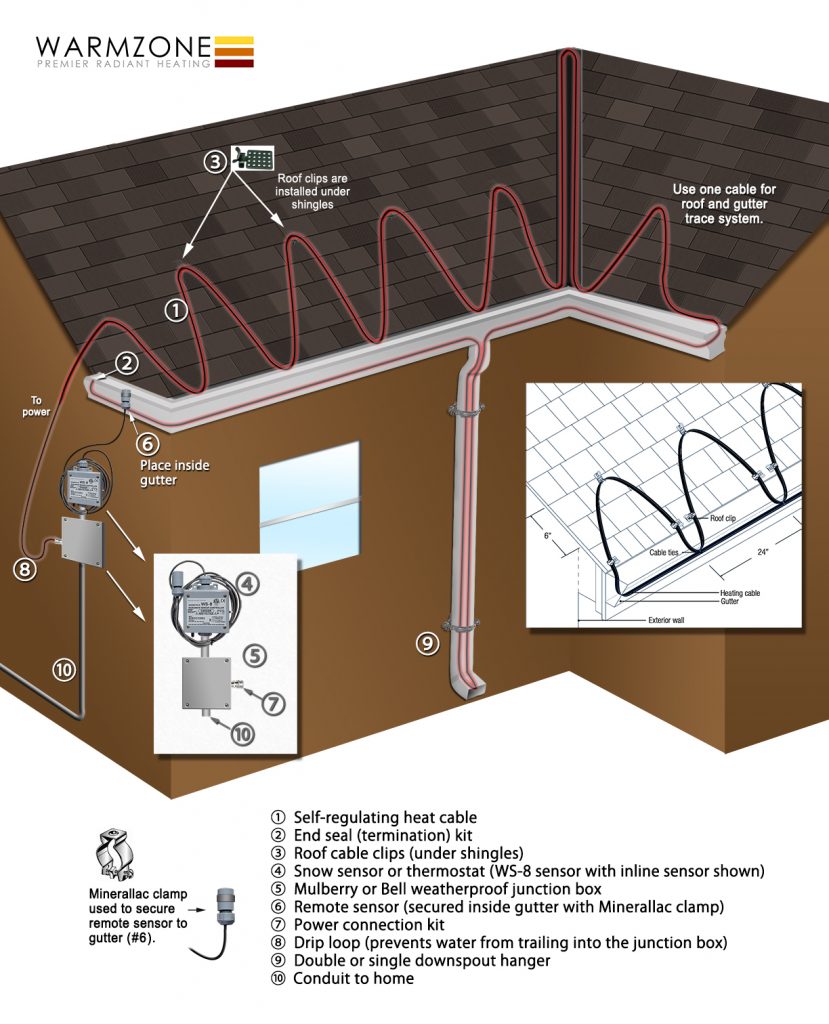
The RoofHeat STEP low-voltage system from Warmzone is the premier roof de-icing solution for almost any application – including metal roofs. Not only is it one of the most trusted and comprehensive roof heating systems available, but it is a perennial favorite of roofing professionals. Rather than cable, RoofHeat STEP’s heating element is a thin (3/64-inch thick), semi-conductive, polymer heating panel that is polypropylene fused during fabrication to increase its durability, making it waterproof and protecting it from alkaline or salt damage. The element is a discreet, flexible panel that is installed directly under shake, asphalt shingles, or even metal roofs. The lightweight (.23 pounds per foot) heating element can also be cut onsite, nailed and stapled through, and is also available in multiple widths (3, 6, 9, and 12 inches). All these factors make installation quick and easy for any rooftop. RoofHeat STEP also comes with a 10-year warranty against manufacturing defects.
The low-voltage system is also self-regulating, and utilizes transformers to operate the system. Each section of the roof is connected to a transformer that will step down from high to low voltage (60 volts or less), and monitor the heat output to the self-regulating heat element to allow for optimal performance. An automatic sensor will detect precipitation and temperature to trigger the control panel, which then sends power to each section. This system setup will assure any roof is heated accurately, evenly, and cleared of snow and ice, while being extremely energy efficient. RoofHeat STEP is a great choice for any home or business, but is better at clearing snow from large areas or entire sections of the roof than self-regulating heat trace cable. It is especially effective at preventing ice dams, and will also keep roof eaves, valleys, or trouble spots completely clear of snow and ice.
The preferred activation device for this de-icing system is the advanced STEP Touch Thermostat. This industry-leading advanced thermostat has a beautiful, modern design sure to please any homeowner. Simple to use with only two-control functionality, it is maintenance free and will work perfectly with the low-voltage system, or any radiant heat system from Warmzone. It has a 3-digit LED display, interfaces with smart-home systems, and has a permanent memory that will recover all settings in the event of a power failure.
An automated roof de-icing system like RoofHeat STEP is key for effective and efficient roof de-icing and preventing hazards at homes and businesses. When working with Warmzone, each de-icing system is custom designed to meet the customer’s budget and de-icing needs. Professionals will consider each aspect of your roof, such as layout, roof medium, budget, and other factors to find the solution that gives you the best roof de-icing system.
In addition to providing a professional layout/design of the roof heating system, Warmzone also offers free installation training and technical support during installation. Customer service professionals from Warmzone are available to assist with any questions to assure installation goes off without a hitch.
If you would like more information about Warmzone’s roof de-icing systems, reach out to us today and speak to a customer service professional at 888-488-9276.
Radiant heat is a great solution for many areas inside or outside your home. From floors to driveways, almost any area in your home can be heated with radiant heat. One great and often overlooked spot to install radiant heating is your roof. Inspecting your roof and installing a roof de-icing system during the warmer months is a great way to ensure your home or business is prepared for the cold winter ahead. With Warmzone, top-of-the-line roof heating systems make dealing with winter hazards like snow, ice dams, or icicles hassle a whole lot easier. Warmzone offers a variety of versatile roof de-icing systems that can fit the needs of any home or business owner and keep property safe from costly water damage during the winter.
Radiant heating systems work using three components: a heating element, an activation device, and a contactor panel / power source. The heating element is installed on your roof, valleys or gutters, or in specific areas where de-icing is needed. Once the heating element is installed, the activation device triggers the system to send power to the elements. The activation device is designed to detect specific weather conditions and then signal the contactor panel to send power to the heating element. The system then safely and efficiently keeps your roof clear of hazardous snow and ice.

Depending on the needs of the area to be heated, de-icing systems can be installed in a number of places. If you are looking to install radiant heat in gutters and downspouts, Warmzone’s self-regulating heat cable is an affordable, efficient solution for roof de-icing. (Constant wattage and pre-terminated self-regulating cable is also available.) Self-regulating heat cable automatically adjusts to temperature changes, increasing or decreasing its heat output, making it extra efficient, safe, and maintenance free. Warmzone’s self-regulating heat cable features a UV stabilized flexible thermoplastic elastomer over-jacket that protects its core making it extremely durable for wet locations, and protecting it from sun damage. This cable can be installed in gutters, downspouts or even zigzagged along the roof eaves to provide channels for the runoff (and prevent ice dams). Installing cable in these particular areas helps prevent icicles and hazardous ice dams from forming, protecting your home and roof from water damage that often results from ridges of ice that form along the roof eaves. Water can pool behind the ice and seep into tiny cracks in the roof or shingles. Warmzone’s versatile self-regulating cable can also be used for pipe tracing applications to prevent pipes from freezing.
Warmzone’s industry leading self-regulated heating cable is also used in attractive roof heating panels. These aluminum panels feature pre-engineered channels where self-regulating heat cable is routed, resulting in maximum heat transfer. These panels are engineered to be extremely energy efficient as well as an attractive addition to your roof. The aluminum panels are coated with a durable finish that adds to the aesthetic value of your home, and are available in a wide variety of colors to match your existing roof. Warmzone’s RoofHeat panels are extremely versatile and are also a great option to heat the valleys of your roof. These panels are effective at controlling ice buildup and dams with just a 4-6 inch heating panel that will clear both sides of the valley between 6-10 inches. This method of roof heating allows runoff to safely flow down the valley and assures that no water is refreezing on any other part of your roof. These premium quality panels offer an aesthetically pleasing option that is both highly efficient and affordable.
Another great roof de-icing option is Warmzone’s low-voltage RoofHeat STEP system. This innovative system features a thin polymer heating element that can be installed under metal or shingle roofs. It is easy to install and versatile, as it can be cut, stapled or nailed through during installation. RoofHeat STEP is also a self regulating system, so you can be sure that the system will efficiently keep your roof clear of snow and ice in any cold weather condition. This system can be installed to heat roof eaves, valleys, or even the entire roof. Each transformer controls a specific section of the roof de-icing system. This allows for the system to step down high voltage to low voltage (less than 60V ) when necessary, providing safe and efficient heat to clear your roof. The low-voltage system is one of the most effective and highly recommended roof de-icing systems on the market.
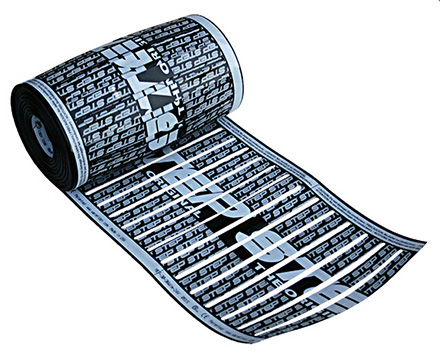
Because Warmzone’s roof de-icing systems are so versatile, they can be used separately or combined. This is helpful to meet the specific needs of each roof. If there is a tricky area, or an especially problematic spot Warmzone professional system designers can create a roof de-icing system to meet your exact specifications and snow melting needs.
Purchasing a roof de-icing system is a smart way to protect one of the most important aspects of your home – the roof. Damage to a roof can lead to costly water damage in the home, which can even lead to serious health problems if mold develops in the home. Ice dams are the number one problem when it comes to water or costly roof damage. As snow melts on the roof, it can reach the ridge of ice along the eaves where it pools. This pooled water can seep into tiny cracks and refreeze in every nook and cranny of your roof, expanding and eventually causing damage and threatening the integrity of your roof. If water seeps inside walls, it may not be discovered for a considerable time, whereby it can eventually cause mold and mildew inside the home – which is every homeowner’s nightmare.
A quality roof heating system is an investment that can pay off every winter, preventing damage and eliminating stress. Installing one now during the summer months is easier, and will assure your winter is safe and hassle free. If you’d like to learn more about the many roof de-icing options that are available, please contact a roof heating expert today at 888.488.9276.
It’s that time of year again. Ice and snow are causing hazardous conditions everywhere, including our homes and businesses. One area of your home you may forget about this winter is your roof. As important as it is, the roof is often an overlooked area during the winter, and not maintaining it can lead to costly repairs. From broken gutters and downspouts to water damage from leaks that can cause mold and mildew, a damaged roof can make your winter season frustrating, cold, and expensive.
An efficient roof deicing system is a great long-term investment in maintenance and safety for any home or business owner, especially when coupled with industry leading customer service and professional system design services provided by Warmzone. Warmzone offers state-of-the-art roof heating systems, including industry leading RoofHeat trace cable and low-voltage RoofHeat STEP to meet the needs of any project.
Warmzone’s roof deicing systems are easy to use and easy to install. These systems have three components: A heating element, a power unit, and an activation device.

RoofHeat self-regulating heat trace cable is an affordable, easy-to-use roof deicing option that is typically installed in gutters, downspouts, or along the roof eaves to help prevent ice dams and icicles from forming. Installation is simple. Determine the length of cable needed and then install it in the gutters and downspouts, and/or attach to the shingles with roof clips.
The self-regulating cable features an irradiated conductive core that increases the heat output as the outside temperature falls and decreases the heat output as the temperature rises. This unique construction makes it durable, safe, and extremely energy efficient.
RoofHeat STEP heating elements feature thin polymer that can be rolled out and cut on site, and even stapled or nailed through when installed under the roof shingles. Each power unit for the low-voltage heating element is connected to control specific areas of your deicing system and monitor the heating elements’ output. These units step down high voltage to low voltage (60 V or less) to safely and efficiently melt snow and ice.
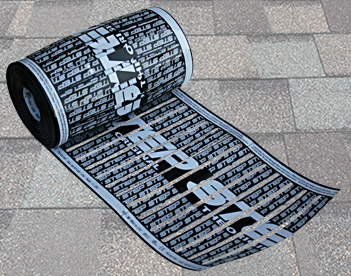
The final component of the low-voltage system is the activation device. While several activation device options are available, Warmzone recommends its state-of-the-art RoofHeat STEP Touch Thermostat. The Touch thermostat works by using a remote sensor to determine temperature to activate the system when it is needed. This activation device is low-profile and features an auto-dimming LED display that interfaces with the outdoor sensor. The user-friendly controller makes operation of your system a cinch. Like the RoofHeat trace cable, the RoofHeat STEP heating element is also self-regulating. This function allows the system to operate safely and at peak performance.
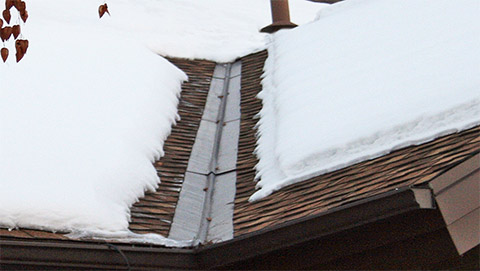
With superior performance and state-of-the-art components, an advanced roof deicing system from Warmzone offers many benefits for your home or business. The first and most obvious is that maintaining your roof prevents costly water or structural damage to your home or business. Heavy snow and ice dams can build in chronic trouble spots on your roof; such as a north-facing valley or roof edge, and block the water from draining properly. This can lead to a compromised roof that leaks, causing damage from your ceiling to your floor, and may lead to mold and mildew growth inside the home.
Maintaining your roof also increases the safety of your home and business. With a RoofHeat system there will be no more worrying about heavy icicles falling and injuring people or creating extra ice on the sidewalk that may lead to falls and severe injuries. Another great benefit of a roof deicing system is the maintenance-free nature of the system. Once installed, the systems don’t require any regular maintenance, so aside from the operation costs, there are no other yearly expenses associated with having a system.
When it comes to operating costs, Warmzone’s self-regulating systems operate extremely efficiently, resulting in low operation cost. While utility prices may vary depending on your location, on average a 300 square foot roof costs around $.35 an hour to operate, making them affordable for any consumer. The automated operation of Warmzone’s RoofHeat STEP and RoofHeat trace cable systems also allows for minimum operation time, decreasing your operating costs. In fact, Warmzone’s heat trace cable system can run up to 30 percent less than other radiant deicing systems, making it a safe, efficient, low-cost choice.
One of the biggest benefits of a RoofHeat deicing system is the versatility. You can install each system on its own, or if you have a tricky area that needs special consideration, you can use both RoofHeat trace cable and RoofHeat STEP elements. When purchasing a top-of-the-line system from Warmzone, you also receive industry leading customer service to help you pick the RoofHeat products that best fit the needs of your project. Warmzone has design specialists to help you every step of the way, assuring your system is perfect for your home or business, as well as free installation training and support.
Still have questions about RoofHeat systems? Contact a Warmzone customer service specialist at 888.488.9276, or check out warmzone.com’s roof deicing pages for information on products and installation today!
According to experts, homeowners should inspect their roofs, gutters and downspouts at least twice a year. Roofing pros suggest checking it during spring time and in late fall, in preparation for the upcoming winter.
Roofs are generally very sturdy and built to last. But sometimes extreme weather or accidents can jeopardize the integrity of a roof. And even the slightest flaw can lead to costly water damage. So before you fall victim to water damage from a leaky roof, make the effort to inspect your home’s lid so you can rest easy during summer rain and winter snowstorms.
Ice dams pose the single greatest threat to roofs in cold climate areas. Ice can cause problems that start out so small it’s difficult for homeowners to recognize. However, the small problem can grow into a large problem and result in serious water damage to the home. The damage may even take years to develop as ice dams tend to form in the same area year after year. That’s why it’s so important to keep up on the biannual inspections.
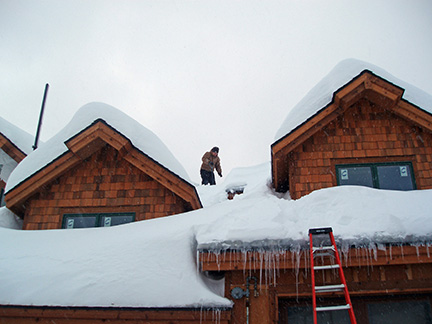
During winter in locations that receive significant snowfall, warm air can escape from the living area and into the attic where it continues upward, warming the roof and causing the bottom layer of snow to melt. The runoff trickles down the roof, but when it reaches the colder eaves (where the roof extends out and no heat from the attic can reach), the water refreezes, causing a small ridge of ice to form.
This process tends to repeat itself day after day, and before long the small ridge of ice has grown into a large ridge. The runoff from the roof eventually pools behind the ice dam, and this is where things can get ugly. When a pool of water sits on a roof, every tiny crack and imperfection in the shingles or plywood can be exploited. Water finds its way into every crack or flaw in the roof. At nighttime the water refreezes and expands, enlarging the cracks and breaking down the overall integrity of the roof.
After your spring inspection of the roof, perhaps now is a good time to invest in an affordable roof deicing system. Several options are available, ranging from affordable self-regulating heat cable to low-voltage polymer heating panels that are installed directly under the roof shingles.
Self-regulating heat cable can be run through roof gutters and downspouts, as well as in a zigzag pattern along the roof eave. By installing the heat cable in a serpentine pattern the cable provides channels for the runoff to reach the gutters, thereby minimizing the chances of ice dams from forming.
The low-voltage RoofHeat STEP system features thin polymer heating panels that can be installed under shingles or metal roofs. The element can be nailed or stapled through and cut on site. The heating element is also self-regulating.

These industry leading roof deicing systems keep the entire roof edges free from snow and ice, whereas the individual runs of heat cable simply provide channels for the runoff. Because the RoofHeat STEP system is low-voltage, it uses transformers to step down high voltage to low voltage (60 V or less). Each transformer controls a specific section of the roof deicing system. And Warmzone roof heating systems can be easily customized to meet the precise needs of each customer.
Industry Leading Support Services
Warmzone is an innovative industry leader in terms of product offering and customer services. Free installation training is provided as well as installation support and professional system design and layout. Electrical and radiant heat experts are on hand to assist you during the training and/or the installation. A library of helpful installation videos is also available on Warmzone’s website, as well as a wealth of product information and documentation.
For more information, check out our website or call us today at 888.488.9276.
During the winter months many homeowners scramble to find a way to protect their roof gutters from heavy ice buildup. Icicles can also form, creating dangerous conditions for pedestrians below. Not only does falling ice present a danger, but melting icicles drip onto the sidewalk below and the water refreezes in the evening, creating a thin sheet of slick ice. Needless to say, these conditions are a nightmare for business owners.
The most popular and trusted method for keeping roof gutters and downspouts free of snow and ice is installing a heat trace system. These affordable systems are easy to install and are fully automated. The reliable, maintenance free roof deicing systems rely on durable self-regulating heat trace cable.
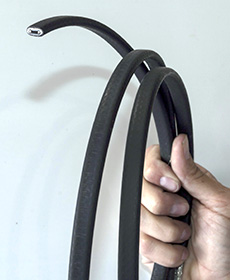
Self-regulating heat cable automatically adjusts its power output to compensate for temperature changes. The cable’s irradiated conductive core increases the heat output as the outside temperature falls and decreases the heat output as the temperature rises. This unique construction makes it durable, safe, and extremely energy efficient.
The UV stabilized, flexible thermoplastic elastomer overjacket protects the durable carbon core for wet applications and exposure to the sun. These features provide more consistent performance, longer lifespan, and easier installation in cold temperatures that most other cable brands. In addition to providing ideal protection for roof and gutter applications, the heat cable can also be used for pipe tracing applications.
The other key component to Warmzone’s industry leading roof deicing and gutter trace system is the WS-8C aerial-mount snow sensor. This advanced sensor is designed primarily for gutter, downspout, and roof ice melting and small satellite antenna deicing. The totally sealed, low voltage, remote mount precipitation sensor allows the user to install the small sensor head in a downspout, the back of a gutter, or at the end of an antenna boom, up to 10 feet away, while keeping the main controller in a more convenient or protected outdoor location.
Warmzone roof heat tracing systems are affordable and effective. And once installed, you never have to worry about it. The system automatically operates when needed.
In addition to installing the cable in roof gutters, downspouts and valleys, the cable can also be zigzagged along the roof’s edge to help break up ice dams. The heat cable prevents water from pooling up behind ice dams by providing channels for the runoff to reach the gutter.
However, if your roof is consistently dealing with ice dams, that may be an indication that your attic is poorly insulated. Certainly, a roof deicing system can be installed at your roof edges to eliminate ice dams, but it is also recommended that you check your attic to ensure that it is properly insulated as well.
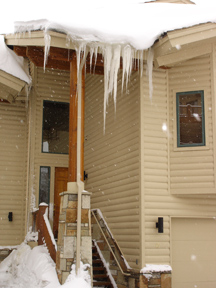
Ice dams form as a result of warm air rising from the home and escaping into the attic where it warms the roof and causes runoff. The melted snow reaches the colder roof overhang and refreezes. Eventually a ridge of ice forms and then subsequent runoff pools behind the ridge of ice. Water can seep under shingles and when it refreezes damage may occur.
Warmzone can provide a variety of custom roof heating solutions for you. Call today and see what options would best suit your needs. Any system can be customized to meet your specific roof heating needs and budget. Call 888.488.9276 today.
Features and Benefits of Warmzone’s Roof Heat Trace Systems
Helpful Roof Information
Most weather related issues for a home begin – or end – with the roof. So, it’s no exaggeration to state that the single most important physical characteristic of a house may be its roof. Trouble areas or a poor quality roof can result in expensive water damage within the house so it’s vital to catch these problems before any damage can be done. As homeowners it’s important for us to inspect and maintain the quality of the roof and consistently ensure the integrity of the roof.
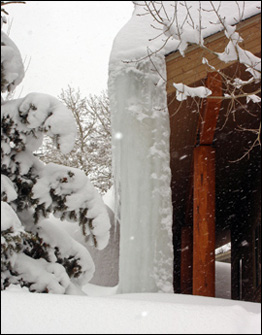
Some important factors to keep in mind are:
What’s the Best Way to Heat My Roof?
Warmzone offers several options when it comes to heating your roof. And each system can be customized to further meet your specific needs.

One of the most popular systems for heating roof edges is the RoofHeat STEP system. This system features thin, low-voltage heating element that is installed directly under the roof shingle. (The system is also safe to install under metal roofs.)
The semi-conductive polyethylene heating element comes in 12-inch wide rolls and can even be nailed or stapled through and cut on site. Other widths are available for heating gutters and downspouts. The heating element is polypropylene fused during fabrication to achieve water proofing and protection from alkaline or salt damage.
Heating Gutters and Downspouts
The ideal solution for heating gutters and downspouts is self-regulating heat cable. The heat cable is effective for heating roof edges, gutters and drainpipes to help prevent costly ice and water damage, frost erosion and dangerous falling ice.
The self-regulating roof and gutter heating cable is extremely effective and energy efficient. The UL listed cable meets the requirements of the NEC (National Electric Code) Section 426. The durable cable features an irradiated conductive core that increases the heat output as the outside temperature falls and decreases the heat output as the temperature rises. This proven construction makes it tough, safe, and extremely energy efficient.
Most residential automated self-regulating heat trace systems consist of the heating element and a thermostat or snow sensor (activation device). (Larger systems may require another contactor, depending upon the power requirements. Heat trace systems rely on the thermostat to activate and keep the gutters and downspouts clear of ice.
Warmzone roof heating systems are fully automated and maintenance free. Warmzone roof deicing systems have been installed in Denver and most other cold regions around the country and are still the most effective and discreet for roof deicing and gutter trace applications.
Roof heating systems can be customized to accommodate just about any roof type and configuration. Warmzone self-reg roof and gutter heating cable may also be combined with other recommended roof heating systems, such as the RoofHeat STEP deicing system to create an optimal solution for you. We’ll work with you to create a customized system to best accommodate your specific snow melting needs as well as your budget. For more information, call 888.488.9276 today.